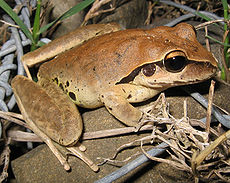
Stoney Creek Frog
Encyclopedia
The Stoney Creek Frog, is a ground dwelling tree frog
(of the family Hylidae, genus Litoria
), found in Eastern Australia
.
 Female Stoney Creek Frogs reach a maximum snout–vent length (SVL) of 70 millimetres (2.8 in). The male's maximum SVL is 43 millimetres (1.7 in). It has reduced toe pads. Like most frogs, the colour of the Stoney Creek Frog is variable. The dorsal
Female Stoney Creek Frogs reach a maximum snout–vent length (SVL) of 70 millimetres (2.8 in). The male's maximum SVL is 43 millimetres (1.7 in). It has reduced toe pads. Like most frogs, the colour of the Stoney Creek Frog is variable. The dorsal
and ventral surfaces range from grey to brown. A thin, black line runs from the snout to the eye, widens after the eye, and continues uninterrupted until the base of the arm. The posterior thighs will be black with yellow or green spots (sometimes hard to detect on a first glance basis).
The Stoney Creek Frog's snout is very useful in the wild. It enables them to stay low under water so that they can stay away from predators. Their snout acts as a ventalation system. When the Stoney Creek Frog swims under water the snout will stick slightly above the water so that it can breathe.
During the mating season, the males congregate around streams/rivers and develop a brilliant lemon-yellow pigment on their skin, which can range from completely covering the body, to just covering the dorsal surface. The brightness of the yellow may vary between individuals.
Can be mistaken for Litoria latopalmata. Tell the difference by posterior thigh markings.
The Stoney Creek Frog is unusual in relation to most of the Litoria genus because it lacks a vocal sack. The call is a series of soft trills, which can only be heard within a few metres of the frog. The frog will call near both moving and still water sources.
(Litoria lesueuri) and is identical physiologically to Litoria jungguy. It can be distinguished from Lesueur's Frog by the presence of blue spots on the thigh, which are missing in the Stoney Creek Frog. Geographical distribution and genetic testing are the only methods of differentiating the Stoney Creek Frog and Litoria jungguy.
Tree frog
Hylidae is a wide-ranging family of frogs commonly referred to as "tree frogs and their allies". However, the hylids include a diversity of frog species, many of which do not live in trees, but are terrestrial or semi-aquatic.-Characteristics:...
(of the family Hylidae, genus Litoria
Litoria
Litoria is a genus of Hylidae tree frogs native to Australia, the Bismarck Archipelago, the Solomon Islands, New Guinea, the Lesser Sunda Islands, the Moluccan Islands, and Timor. They are sometimes collectively referred to as Australasian treefrogs...
), found in Eastern Australia
Australia
Australia , officially the Commonwealth of Australia, is a country in the Southern Hemisphere comprising the mainland of the Australian continent, the island of Tasmania, and numerous smaller islands in the Indian and Pacific Oceans. It is the world's sixth-largest country by total area...
.
Physical description

Dorsum (biology)
In anatomy, the dorsum is the upper side of animals that typically run, fly, or swim in a horizontal position, and the back side of animals that walk upright. In vertebrates the dorsum contains the backbone. The term dorsal refers to anatomical structures that are either situated toward or grow...
and ventral surfaces range from grey to brown. A thin, black line runs from the snout to the eye, widens after the eye, and continues uninterrupted until the base of the arm. The posterior thighs will be black with yellow or green spots (sometimes hard to detect on a first glance basis).
The Stoney Creek Frog's snout is very useful in the wild. It enables them to stay low under water so that they can stay away from predators. Their snout acts as a ventalation system. When the Stoney Creek Frog swims under water the snout will stick slightly above the water so that it can breathe.
During the mating season, the males congregate around streams/rivers and develop a brilliant lemon-yellow pigment on their skin, which can range from completely covering the body, to just covering the dorsal surface. The brightness of the yellow may vary between individuals.
Can be mistaken for Litoria latopalmata. Tell the difference by posterior thigh markings.
Ecology and behaviour
This species is found in woodland, rainforest and sclerophyll forest. It is normally associated with rocky flowing streams, however it will also inhabit dams in suitable forest.The Stoney Creek Frog is unusual in relation to most of the Litoria genus because it lacks a vocal sack. The call is a series of soft trills, which can only be heard within a few metres of the frog. The frog will call near both moving and still water sources.
Taxonomy
This species is almost identical physiologically to Lesueur's FrogLesueur's Frog
Lesueur's Frog is a species of ground-dwelling tree frog native to south-eastern Australia, from Sydney, New South Wales to eastern Victoria.-Physical description:...
(Litoria lesueuri) and is identical physiologically to Litoria jungguy. It can be distinguished from Lesueur's Frog by the presence of blue spots on the thigh, which are missing in the Stoney Creek Frog. Geographical distribution and genetic testing are the only methods of differentiating the Stoney Creek Frog and Litoria jungguy.

